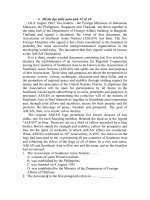- Trang chủ >>
- Đề thi >>
- Đề thi lớp 12
Đề thi đọc hiểu môn anh 12 số 6
Bạn đang xem bản rút gọn của tài liệu. Xem và tải ngay bản đầy đủ của tài liệu tại đây (69.8 KB, 2 trang )
Đề thi đọc hiểu môn anh 12 số 6
By the year 2025, the Earth could lose as many as one fifth of all
species known to exist today. In recent centuries, hundreds of species
have disappeared, almost always as a result of human activities. The
passenger pigeon, one familiar example, was a source of food until
excessive hunting and habitat loss caused its extinction in 1914. The
North American bison, whose populations were decimated by settlers and
market hunters in the 1800s, came close to sharing the same fate. Bison
survive today only because of the efforts of early conservationists.
Today, species require such efforts more urgently than ever. An
essential task that falls to present-day conservationists is to determine
which species are most, endangered, so that conservation resources' can
be applied where action is needed most. Species are categorized by the
degree to which their survival in the wild is threatened. World Wildlife
Fund offers a sampling of animals and plants that fall mainly within the
two most serious categories of- threat: critically endangered and
endangered. What threatens these species' existence? Some of the top
threats are habitat destruction by unsustainable logging and ever-
encroaching human settlement; pollution of water, soil, and air by toxic
chemicals; unnatural climate changes due to fossil fuel use; unmanaged
fishing that exhausts fish stocks; and illegal hunting to supply the demand
for skins, hides, traditional medicines, food, and tourist souvenirs. The
list which conservationists presents only a fraction of the species at risk
of extinction today and does not include thousands of species whose
status we do not yet know. Hundreds of species without common names
have been left out, which means that while many mammals are on this
list, only a few insects and mollusks are included.
Species listed here range from the largest animal on Earth, the blue
whale, to the majestic tiger, to the humble thick-shell pond snail. Large or
small, beautiful or ugly, all species play a role in the complex circle of
life. All of us depend on the natural resources of our planet. Each time a
species is lost, the complexity, natural balance, and beauty of our world is
diminished. And what threatens plants and animals ultimately threatens
people as well.
1. According to the first paragraph …….
A. species extinction is only caused by hunting
B. human beings protect wife life much more than they do harm to
them
C. the main cause of species extinction is human activities
D. we can stop radically species extinction by 2025
2. The North American bison …….
A. was completely extinct in 1800sB. was not the aim of human
hunting
C. was raised by settlers in 1800s D. has escaped from extinction
thanks to conservationists
3. Species are categorized …….
A. to prevent hunting B. to provide food
C. to destroy their habitats D. to give preferential right to conserve
4. Which sentence is true?
A. Medicine is not a factor to cause species extinction.
B. The list which conservationists present does not include all kinds of
species.
C. Pollution does nothing to species extinction.
D. Conservationists have good knowledge of all kinds of mollusks.
5. According to the last paragraph, …….
A. species extinction has no relationship to human beings
B. what threaten plants and animals can do nothing to human beings
C. human beings depend on natural resources to survive
D. not every, species has a role in the circle of life.
KEY: 1. C 2. D 3. D 4. B 5. C








